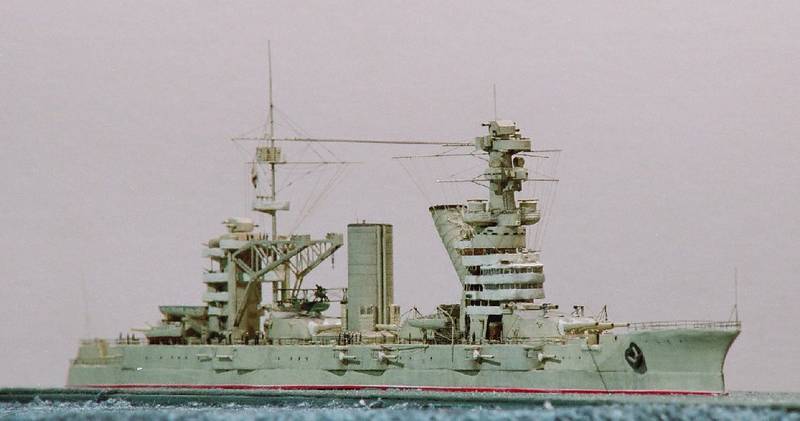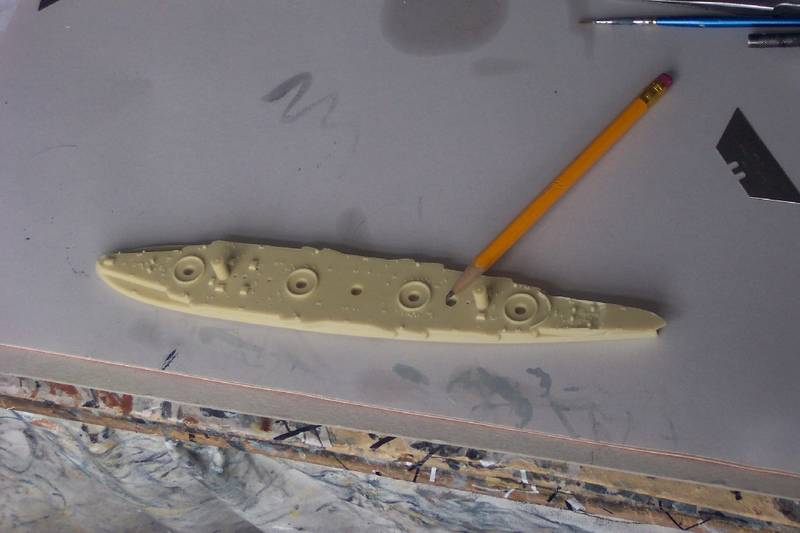You are viewing the archived version of the site.
Go to modelshipwrights.com for the current dynamic site!
Go to modelshipwrights.com for the current dynamic site!
1⁄35Building the Oktabriskaya Revolutsia
1
Comment

The full history of the class as a whole I have presented here below: (with kind permission of the author Vladimir Yabukov)
Gangut class Battleships
Some of the longest serving battleships in the world, the Gangut(or as the were known in the Russian navy - Sevastopol) class ships had eventful careers. They fought in four wars, took part in three revolutions and outlived all but one of their contemporaries while losing 50% of the class in the process.
Four battleships of the class (Petropavlovsk, Sevastopol, Gangut and Poltava - named after famous Russian battles) were laid down in June 1909 and at the time were some of the most powerful battleships designed. Unfortunately their long building times meant that by the time they entered service in November 1914 British /Queen Elisabeth/ class battleships were nearing completion, and they were becoming obsolete. They displaced 23,300 tons, had top speed of 24 knots and were armed with twelve powerful 12" guns in four triple turrets. Their guns were the most powerful 12" guns used in WWI with the heaviest shell of any 12" gun before American /Alaska/ class in 1940s, another distinctive feature of the design was the fact that the guns elevated to 25 degrees where most of their contemporaries only managed 12 to 15 degree elevation.
Their most interesting feature was the armor scheme which was uniquely Russian and was a direct consequence of the defeat at Tsushima. At Tsushima Russian ships were turned into burning pyres by the rain of Japanese HE shells hitting their unarmored sides, while even modest armor was not penetrated by them. So as a consequence of that Russian navy theorized that the best way to protect a Battleship is to armor as much of the hull as possible with modest armor, so in a complete antithesis to the American All-or-Nothing scheme almost entire hull was armored, but the main belt was only 225mm thick. While this was justifiable in the view of the performance of German and British shells at Jutland, later in their careers when AP shells that actually worked appeared they became woefully underarmored.
All four ships entered service within 2 months of each other in November 1914 - January 1915. Throughout WWI they patrolled the minefield positions at the mouth of the Gulf of Finland, only venturing out of the gulf twice, when Petropavlovsk and Gangut covered minelaying operations in near Gotland in Oct-Nov 1915. Since they were the only Russian dreadnought type battleships in the Baltic, Russian high command was very reluctant to risk them and they never fired their guns at the enemy in anger during the war. That also led to their bored crews being involved in revolutionary activities.
There was a minor mutiny on board two of them in 1915 and their crews took active part in both March and October 1917 Revolutions. All four ships took part in the epic Ice Voyage in March 1918 when the ships of the Russian Navy were withdrawn back to Kronshtadt from their forward bases through the ice covered Gulf of Finland to prevent them from being captured by the advancing Germans. After that due to the start of the Civil War all but one of them (Petropavlovsk) were placed in reserve.
In a tragic twist of fate the ships that never fired at the Germans during WWI, were used to fire on fellow Russians and the former allies during the Civil War. First, on 31 May 1919 as one of the few operational ships of the Red Navy in the Baltic Petropavlovsk was covering a reconnaissance of the British forces by Red Navy destroyer Azard, when they were attacked by 8 British destroyers. Petropavlovsk was able to drive them off, but no ships on either side were hit. This, surprisingly, was the only time in their 42 year long careers when any of the Gangut class battleships were involved in the ships to ship action. In June 1919 the garrisons of the two forts on the Southern coast of the Gulf of Finland mutinied against the Soviets and Petropavlovsk was involved in shelling them into submission. In August 1919 the British claimed to have sunk Petropavlovsk in a MTB raid on Kronshtadt.
That myth has persisted until the end of the cold war, but in reality the torpedo missed and hit the pier next to the ship. In November 1919 the class suffered its first loss when Poltava, that has been ostensibly placed in reserve, but in reality was all but abandoned pier side caught fire and burned for over a day and half. The resulting damage was so great that despite that fact that the hull was kept around until after WWII and there were periodic half hearted attempts to repair the ship, it was never operational again. Last time the ships were in action during the Civil War was in March 1921, when they went into action on the anti-government side. In March 1921 the sailors of the Kronshtadt Naval Base mutinied, led mostly by the battleship crews, and declared their intention to start a third revolution. In the ironic change the forts that they helped silence in 1919 now fired on them on the side of the government. Despite heavy fire from the battleships (almost 700 12" rounds were fired by them), the mutiny was crushed in 8 days. The ships were subsequently renamed - Gangut to Oktyabr'skaya Revolutsiya, Sevastopol to Parizhskaya Kommuna, Petropavlovsk to Marat and Poltava to Frunze..
Next several years the ships were mostly in reserve, but starting from 1922-24 they were slowly being repaired and brought back into operational readiness. Several years of routine maneuvers followed as Red Navy was rebuilding itself. In 1929 Parizhskaya Kommuna along with a cruiser Profintern left Baltic for the last time and transited to the Black Sea (the only time the ships of this class visited an ocean). Starting from 1931 until 1938 these three ships were being slowly modernized. Superstructures were build up, boilers replaced and AA guns added. /Parizhskaya Kommuna/ was modernized the most - mid-deck armor was strengthened from 25mm to 76mm, gun elevation was increased to 40 degrees, and anti-torpedo bulges were added which brought the displacement up to almost 31,000 tons. Baltic ships were also modernized, but to the lesser extent.
Baltic ships were active during the Winter War shelling Finnish positions and coast defense batteries. Two ships fired almost 400 12" rounds at the Finns during the conflict. All three ships were active in WWII, through not in the same way as the ships of the other navies - instead of the ocean operations, they were used a floating batteries due to the nature of the conflict in the East. In September 1941 both Baltic ships were extremely active in support of the defenders of Leningrad. /Marat/ alone fired 1042 12" shells in the span of eight days. They also faced some of the heaviest air strikes faced by any ships during WWII, each sustaining several damaging but non-disabling hits. On 23 September 1941 Marat was hit by two 500 or 1000kg bombs, which pierced the deck armor and caused the explosion of the forward 12" magazine. The entire forward third of the ship was destroyed, 326 men died and the ship settled to the bottom of the harbor (which fortunately was only two meter below the bottom of the ship). Yet amazingly two aft turrets of the ship remained operational and on October 31 they were back in action.
By mid 1942 the #2 turret was also repaired. Both ships were active throughout the Blockade and Oktyabr'skaya Revolutsiya was the last ship of the class to fire its gun in anger when it shelled Finnish positions on 9 June 1944 (and obtained two direct hits on the concrete strong points at the distance of 30,000 meters).
In the Black Sea Parizhskaya Kommuna was active until mid-1943, shelling German troops and delivering supplies to besieged Sevastopol. Throughout the war the AA armament of the ships continued to increase and by the end of the war Oktyabr'skaya Revolutsiya carried twelve 76mm, twenty 37mm guns and sixteen 12.7mm machine guns. By the end of 1943 both Parizhskaya Kommuna and Marat reverted to their old names, while after the war what was left of Marat was renamed Volkhov. These ships had an active post war life as training ships, even Volkhov survived until 1952 as a non-selfpropelled school ship, while the other two sisters were stricken in 1956
Building the Model....
Oktabriskaya Revolutsiya, built in 1914 was originally called Gangut, she languished unused and poorly maintained during the Russian civil war which followed the 1917 Revolution. Re-activated by the Soviet Government in the early 1920's, she was renamed Oktabriskaya Revolutsia (October Revolution) In the early 1930's she underwent an extensive modernisation and rebuild. She retained the symetrical 4 turret layout-- but gained a new flared clipper bow along with a new lofty forward superstructure which required the aft-swept funnel with its S-bend to clear smoke from the upper bridge levels. These features coupled with the two enormous boat and aircraft cranes made for a truly unique profile, which is among the most distinctive of any warship ever. She was affectionatly named Oktabrina by her crew.
There are various 1/700 kits available of the Gangut class, and they vary in quality: for the full Gangut kit story click here.
I aquired this HP kit of the ship unseen off e-bay Germany from fellow modeller Martin Kohring who was thinning out his collection.
Once I had the kit in my possesion its greatest flaw came to light immediately; the total abscence of any kind of deck-planking....!!

Oktabrina like most ships had her decks laid fore-and-aft but bisected in the russian shipbuilding manner of the time by metal strips running athartships. Having inspected the hull casting-which is fundamentaly accurate dimensionally-I found the casemates were not sufficiently high when compared to photos--and with this finding I formulated the Oktabrina kit rescue plan!
Comments
Another one of my JB favourites, always a treat to study this build.
Peter F
AUG 06, 2007 - 07:56 PM
Copyright ©2021 by Jim Baumann. _OPINIONS Model Shipwrights, KitMaker Network, or Silver Star Enterrpises. Images also by copyright holder unless otherwise noted. Opinions expressed are those of the author(s) and not necessarily those of Model Shipwrights. All rights reserved. Originally published on: 2007-07-20 00:00:00. Unique Reads: 7685








